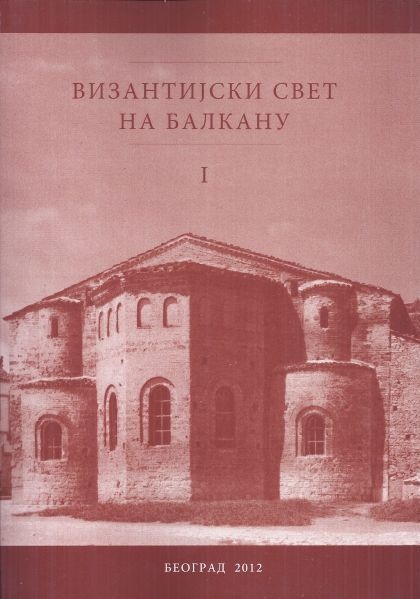Сакос црквених достојанственика у средњовековној Србији
The Sakkos of Ecclesiastical Dignitaries in Medieval Serbia
Author(s): Tatjana Starodubcev
Subject(s): Cultural history, Visual Arts, 13th to 14th Centuries, Eastern Orthodoxy
Published by: Vizantološki institut SANU
Summary/Abstract: The sakkos of ecclesiastical dignitaries is festive attire of a rectangular cut, joined at the sides, with very short sleeves. Previous researchers have pointed out that only three Byzantine writers wrote about it. They were Theodore Balsamon, chartophylax of St. Sophia in Constantinople and the Patriarch of Antioch (second half of the 12th century), Ohrid Archbishop Demetrios Chomatenos (first half of the 13th century) and Archbishop Symeon of Thessaloniki (first decades of the 15th century).
There is no preserved written source that would testify which Serbian church dignitaries wore the sakkos and when they received the right to wear it. The only sources on the use of the sakkos in the Serbian Church are the preserved representations of its highest dignitaries. St. Sava of Serbia and his successors — archbishops and later, patriarchs — were depicted wearing the sakkos. The oldest paintings date back to the reign of King Milutin (Figs. 1–2). Some time later, in 1334, the ancient city of Ohrid was included in the Serbian state. Its archbishops enjoyed the right assigned to them much earlier, to wear the sakkos, and they retained that right. So in the Serbian Church, the sakkos was worn by the archbishops and later patriarchs, and the Ohrid archbishops, as well.
The oldest preserved pictures of the Serbian archbishops clad in the sakkos are the representation of St. Sava of Serbia in the narthex of the Virgin Ljevi{ka church (Fig. 1), decorated between 1307 and 1313, and the portrait of Archbishop Sava III in the illustration of the Christmas sticheron in the passage that leads to the narthex in @i~a (Fig. 2), painted between 1309 and 1316.
That means that awarding the right to wear the sakkos occurred in 1313, at the latest. It certainly was not only a religious but also a political gesture. Byzantine state policy toward Serbia and probably church policy as well, significantly changed for the better during the reigns of Emperor Andronicus II and King Milutin. That created fertile ground, enabling the Serbian church dignitaries to receive the honor to wear the most festive ecclesiastical vestments. The Byzantine emperor, apparently, could have had a major influence on the process of bringing such a decision. However, the question arises as to which patriarch of Constantinople granted this right to the Serbian archbishops. At the beginning of the 14th century, the ecumenical patriarchs were John XII Cosmas (January 1, 1294 to June 21, 1303), Athanasius I (second time, from June 23, 1303 to September 1309) and Niphon I (May 9, 1310 to April 11, 1314). At that time, the throne of the Serbian archbishops was occupied by Eustatius II (1292–1309) and Sava III (1309–1316).
Very little is known about these Serbian archbishops. On the other hand, there are numerous sources about the Church's policies and attitudes of the mentioned Constantinople patriarchs. Eustatius II could have received the right to wear the sakkos from John XII Cosmas or Athanasios I. For a long time, the former was fiercely opposed to the marriage of the Serbian king and the daughter of the Byzantine emperor. The latter maintained a very strict attitude. He left data on almost all of his moves in numerous letters, in which such a decision is not mentioned. Therefore, the probability that the first Serbian archbishop who received the sakkos was Eustatius II is negligible. Sava III could have obtained that right from Niphon I. That patriarch, along with an inclination for the easy life, pursued a conciliatory policy and pragmatism. So it is possible that, on the initiative of the emperor, he made the decision that the successors to the throne of St. Sava of Serbia should have the right to wear the sakkos. If this assumption is correct, then the Serbian archbishops received the honor to wear the most festive ecclesiastical garments after the appointment of Niphon I to the throne of the Constantinople patriarchs, which was performed on May 9, 1310.
Anyway, this occurred after many changes in the political relations between the Byzantine and the Serbian state during the reigns of Emperor Andronicus II and King Milutin. In those crucial years the Serbian Church advanced from an organization whose canonical foundation was denied at the time of Michael VIII Palaeologos, to the archbishopric whose leaders received the right to wear the festive sakkos, like those worn by the ecumenical patriarchs at the time of Andronicus II.
Book: Византијски свет на Балкану I-II
- Page Range: 523-550
- Page Count: 28
- Publication Year: 2012
- Language: Serbian
- Content File-PDF

